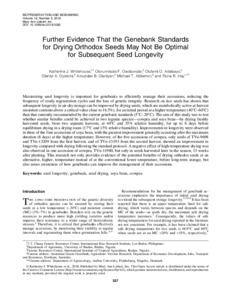| dc.contributor.author | Whitehouse, K.J. |
| dc.contributor.author | Owoborode, O.F. |
| dc.contributor.author | Adebayo, O.O. |
| dc.contributor.author | Oyatomi, O.A. |
| dc.contributor.author | Olaniyan, A.B. |
| dc.contributor.author | Abberton, M.T. |
| dc.contributor.author | Hay, F.R. |
| dc.date.accessioned | 2019-12-04T11:26:30Z |
| dc.date.available | 2019-12-04T11:26:30Z |
| dc.date.issued | 2018-10-12 |
| dc.identifier.citation | Whitehouse, K.J., Owoborode, O.F., Adebayo, O.O., Oyatomi, O.A., Olaniyan, A.B., Abberton, M. & Hay, F.R. (2018). Further evidence that the Genebank standards for drying orthodox seeds may not be optimal for subsequent seed longevity. Biopreservation and Biobanking, 16(5), 327-336. |
| dc.identifier.issn | 1947-5535 |
| dc.identifier.uri | https://hdl.handle.net/20.500.12478/4629 |
| dc.description | Open Access Article |
| dc.description.abstract | Maximizing seed longevity is important for genebanks to efficiently manage their accessions, reducing the frequency of costly regeneration cycles and the loss of genetic integrity. Research on rice seeds has shown that subsequent longevity in air-dry storage can be improved by drying seeds, which are metabolically active at harvest (moisture contents above a critical value close to 16.5%), for an initial period at a higher temperature (40°C–60°C) than that currently recommended by the current genebank standards (5°C–20°C). The aim of this study was to test whether similar benefits could be achieved in two legume species—cowpea and soya bean—by drying freshly harvested seeds, from two separate harvests, at 40°C and 35% relative humidity, for up to 8 days before equilibrium drying in a drying room (17°C and 15% relative humidity). Improvements in longevity were observed in three of the four accessions of soya bean, with the greatest improvement generally occurring after the maximum duration (8 days) at the higher temperature. However, of the five accessions of cowpea, only seeds of TVu-9698 and TVu-13209 from the first harvest, and of TVu-13193 from the second harvest, showed an improvement in longevity compared with drying following the standard protocol. A negative effect of high-temperature drying was also observed in one accession of cowpea, TVu-11980, but only in seeds harvested later in the season, 13 weeks after planting. This research not only provides evidence of the potential benefits of drying orthodox seeds at an alternative, higher, temperature instead of at the conventional lower temperature, before long-term storage, but also raises awareness of how genebanks can improve the management of their accessions. |
| dc.format.extent | 327-336 |
| dc.language.iso | en |
| dc.rights | CC-BY-4.0 |
| dc.subject | Seed Longevity |
| dc.subject | Cowpeas |
| dc.subject | Soybeans |
| dc.subject | Gene Banks |
| dc.title | Further evidence that the Genebank standards for drying orthodox seeds may not be optimal for subsequent seed longevity |
| dc.type | Journal Article |
| dc.description.version | Peer Review |
| cg.contributor.crp | Climate Change, Agriculture and Food Security |
| cg.contributor.crp | Roots, Tubers and Bananas |
| cg.contributor.affiliation | International Rice Research Institute |
| cg.contributor.affiliation | University of Ibadan |
| cg.contributor.affiliation | International Institute of Tropical Agriculture |
| cg.coverage.region | Africa |
| cg.coverage.region | West Africa |
| cg.coverage.country | Nigeria |
| cg.creator.identifier | Michael Abberton: 0000-0003-2555-9591 |
| cg.researchtheme | BIOTECH & PLANT BREEDING |
| cg.isijournal | ISI Journal |
| cg.authorship.types | CGIAR and developing country institute |
| cg.iitasubject | Genetic Improvement |
| cg.iitasubject | Grain Legumes |
| cg.iitasubject | Plant Breeding |
| cg.journal | Biopreservation and Biobanking |
| cg.howpublished | Formally Published |
| cg.accessibilitystatus | Open Access |
| local.dspaceid | 101308 |
| cg.targetaudience | Scientists |
| cg.identifier.doi | https://dx.doi.org/10.1089/bio.2018.0026 |

